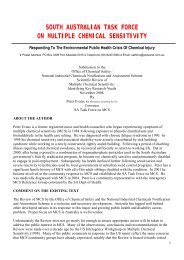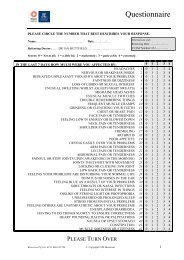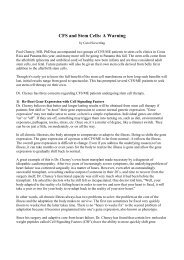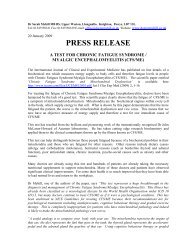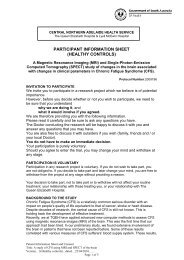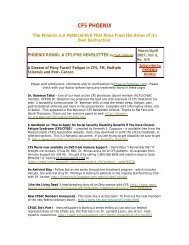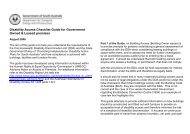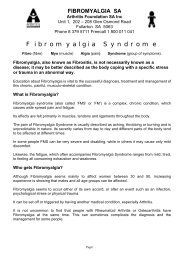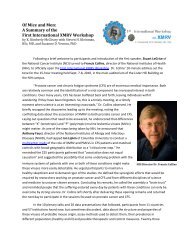76 L. Altomonte et al.treatments derived from traditional Chinese medicineor from other disciplines.Finally, a website developed by Dr. Weiss (52) providesinteresting, evidence-based, accepted informationfor FM patients This site provides a videoof exercise and muscle relaxation techniques thatpatients can learn and use at home on TV; in addition,the site provides evidence for the positive effectscrio-therapy on pain perception in FM patients.CONCLUSIONPrevention may occur in clinical, community orpopulation settings and is often classified into primary,secondary and tertiary types. Few studieshave analyzed the economic impact of FM in termsof costs of disease and pharmacoeconomic balance.The internet is one of the most significant examplesof coordination of information, research, care andvoluntary patient advocacy of FM.SUMMARYThere many open questions concerning the concept of primary prevention in FM. Diagnostic or classification criteriaare not universally accepted, and this leads to difficulties in establishing the onset and duration of the disease. In thecase of FM, primary prevention may consist of the immediate care of acute pain or treatment for affective disturbancesas we do not have any specific laboratory or instrumental tests to determine risk factors of the disease. The goal of secondaryprevention is early detection of the disease when patients are largely asymptomatic and intervention improvesoutcome. Screening allows for identification of an unrecognized disease or risk factor, which, for potential FM patients,includes analysis of tender points, Fibromyalgia Impact Questionnaire (FIQ), pain location and intensity, andfatigue and sleep complaints. Tertiary prevention inhibits further deterioration or reduces complications after the diseasehas developed. In FM the aim of treatment is to decrease pain and increase function via multimodal therapeuticstrategies, which, in most cases, includes pharmacological and non-pharmacological interventions. Patients with FMare high consumers of health care services, and FM is associated with significant productivity-related costs. The degreeof disability and the number of comorbidities are strongly associated with costs. An earlier diagnosis of FM canreduce referral costs and investigations, thus, leading to a net savings for the health care sector. However, every socialassessment is closely related to the socio-economic level of the general population and to the legislation of the countryin which the FM patient resides.Key words - Prevention, economic aspects, screening, disability.Parole chiave - Prevenzione, aspetti economici, screening, disabilità.REFERENCES1. Hauser W, Zimer C, Felde E, Kollner V. What are thekey symptoms of fibromyalgia? Results of a survey ofthe German Fibromyalgia Association. Schmerz 2007.2. Buskila D, Sarzi-Puttini P. Biology and therapy of fibromyalgia.Genetic aspects of fibromyalgia syndrome.Arthtritis Res Ter 2006; 8: 218.3. Martinez-Lavin M. Biology and therapy of fibromyalgia.Stress, the stress response system and fibromyagia.Arthtritis Res Ther 2007; 9: 216.4. Wolfe F, Smythe HA, Yunus MB, Bennett RM, BombardierC, Goldenberg DL, et al. The American Collegeof Rheumatology 1990 criteria for the classification offibromyalgia: report of a multicenter criteria committee.Artrhritis Rheum1990; 33: 160-72.5. Mease P. Fibromyalgia syndrome: review of clinicalpresentation, pathogenesis, outcome measures andtreatment. J Rheumatol 2005; 75: 6-21.6. Webb R, Bramah T, Lunt M, Urwin M, Allison T, SymmonsD. Prevalence and predictors of intense, chronicand disabling neck and back pain in the UK generalpopulation Spine 2003; 28: 1195-202.7. Rao JK, Hootman JM. Prevention research and rheu -matic disease. Curr Opin Rheumatol 2004; 16: 119-24.8. Gieseke T, Gracely RH, Willams DA, Geisser <strong>ME</strong>, PetzkeFW, Clauw DJ. The relationship between depression,clinical pain and experimental pain in chronic paincohort. Arthritis Rheum 2005; 52: 1574-84.9. Theorell T, Harms-Ringdahl K, Ahlberg-Hulten G, WestinB. Psycosocial job factors and symptoms from the locomotorsystem-a multicausal analysis. Scand J RehabilMed 1991; 23: 165-73.10. McBeth J, Macfarlane GJ, Hunt IM, Silman AJ. Riskfactors for persisten chronic widespread pain: a community-basedstudy Rheumatology (Oxford) 20<strong>01</strong>; 40:95-1<strong>01</strong>.11. Allison TR, Symmons DP, Brammah T, Haynes P,Rogers A, Roxby M, et al. Muscoloskeletal pain is moregeneralised among people from ethnic minorities thanamong white people in Greather Manchester. AnnRheum Dis 2002; 61: 151-6.12. Goldberg MS, Scott SC, Mayo NE. A review of the associationbetween cigarette smoking and the developmentof non specific back pain and related outcomesSpine 200; 25: 995-1<strong>01</strong>4.13. Walker-Bone K, Cooper C. Hard work never hurt anyone:or did it? A review of occupational associations
Fibromyalgia syndrome: preventive, social and economic aspects 77with soft tissue musculoskeletal disorders of the neckand upper limb. Ann Rheum Dis 205; 64:1391-6.14. Bazzichi L, Rossi A, Giuliano T, De Feo F, GiacomelliC, Consensi A, el al. Association between thyroid autoimmunityand fibromyalgic disease severity. ClinRheumatol 2007; 26: 2115-20.15. Sarzi-Puttini P, Atzeni F, Turiel M, Furlan R, VulpioL, Carrabba M, Pace F. The Italian version of the FibrofatigueScale, a reliable tool for the evaluation of fibromyalgiasympoms. J Psychosom Res 2004; 56: 213-16.16. Sarzi-Puttini P, Atzeni F, Fiorini T, Panni B, RandisiG, Turiel M, et al. Validation of an Italia version of theFibromyalgia Impact Questionnaire (FIQ-1) Clin ExpRheumatol 2003; 21: 459-64.17. Sarzi-Puttini P, Buskila D, Carrabba M, Doria A,Atzeni F. Treatment strategy in Fibromylgia Sindrome:where are we now? Semin. Arthritis Rheum 2008; 37:353-65.18. Cazzola M, Sarzi-Puttini P, Buskila D, Atzeni F. Pharmacologicaltreatment of fibromyalgia. Reumatismo2007; 59: 280-91.19. McCain GA. A cost-effective approach to the diagnosisand treatment of fibromyalgia. Rheum Dis ClinNorth Am 1996; 22; 323-49.20. Goossens <strong>ME</strong>, Rutten-van Molken MP, Vlaeyn JW,van der Linden SM. The cost diary: a method to measuredirect and indirect costs in cost-effectiveness research.J Clin Epidemiol 2000; 53: 688-95.21. Walen HR, Cronan PA, Bibatti SM. Factors associatedwith healthcare costs in women with fibromyalgia. AmJ Manag Care 20<strong>01</strong>; 25: 39-47.22. Oliver K,Cronan TA, Walen HR Tomita M. Effects ofsocial support and education on health care costs for patientswith fibromyalgia J Rheumatol 20<strong>01</strong>; 28: 2711-9.23. Pfeiffer A, Thompson JM, Nelson A, Tuker S, LuedkteC, Finnie S, et al. Effects of a 1.5 day multidisciplinaryoutpatient treatment program for fibromyalgia: apilot study Am J Phys Med. Rehabil 2003; 82: 186-91.24. Buesing AR A conservative, cost-effective approach tofibromyalgia JAAPA 2005; 18: 32-7.25. Ribinson RL, Jones ML. In search of pharmacoeconomicevaluations fof fibromyalgia treatments: a reviewExpert Opin Pharmacother 2006; 7: 1027-39.26. Lind BK, Lafferty WE, Tyree PT, Diehr PK, GrembowskiDE. Use of complementary and alternativemedicine providers by fibromyalgia patients under insurancecoverage Arthritis Rheum 2007; 57: 71-6.27. Zijlstra TR Braakman-Jansen LM, Taal E, Rasker JJ,van der Laar MA. Cost-effectiveness of Spa treatmentfor fibromyalgia: general health improvement is not forfree Rheumatology 2007; 46: 1454-59.28. Wolfe F, Anderson J, Harkness D, Bennett RM, CaroXJ, Goldenberg DL, et al. A prospective, longitudinal,multicentric study on service utilization and costs in fibromyalgia.Arthritis Rheum 1997; 40: 1560-70.29. With KP, Speechley M, Harth M,Ostbye T. The LondonFibromyalgia Epidemiology Study: direct healthcare costs of fibromyalgia syndrome in London,CanadaJ Rheumatol 1999; 26: 885-9.30. Robinson RL, Bimbaum HG, Morley MA, Sisitsky T,Greenberg PE, Claxton AJ. Economic cost and epidemiologicalcharacteristics of patients with fibromyalgiaclaims J Rheumatol 2003; 30: 1318-25.31. Penrod JR, Bernatsky S, Adam V, Baron M, Dayan N,Dobkin PL. Healh services costs and their detrminatsin women with fibromyalgia J Rheumatol 2004; 31:1391-8.32. Boonen A, van den Heuvel L, van Tubergen A,Goosens M, Severens Jl, van der Heijde D, et al. Largedifferences in cost of illness and well being betweenpatients with fibromyalgia, chronic low back pain orankylosing spondylitis Ann Rheum Dis 2005; 64: 396-402.33. Robinson RL, Bimbauem HG, Morley MA, Sisitsky T,Greeberg PE, Wolfe F. Depression and fibromyalgia:treatment and cost when diagnosed separately or concurrently.J Rheumatol 2004; 31: 1621-9.34. Berger A, Dukes E, Martin S, Edelsberg J, Oster G.Characteristics and healthcare costs of patients withfibromyalgia syndrome Int J Clin Pract 2007; 61: 1498-508.35. With LA, Bimbaum HG, Kaltenboeck A, Tang J, MallettD, Robinson RL. Employees with fibromyalgia;medical comorbidity, healthcare costs and work loss.Occup Environ Med 2008; 50: 13-24.36. www.istat.it37. www.inps.it38. www.inail.it39. www.disabilitaincifre.it40. Burkhardt C, Clark SR, Bennet RM. The FibromyalgiaImpact Questionnaire: development and validation.J Rheumatol 1991;18: 728-33.41. Marsico A. Malattie reumatiche : impatto nel mondodel lavoro del 2000. atti del III Congresso Nazionaledei Reumatologi Ospedalieri Terme di Telese (BN) 9-11 dicembre 1999; 73-8.42. Gerloni V, Ghirardini M, Fantini F. Assessmnt of nonarticular tenderness and prevalence of primary fibromyalgiasyndrome in healthy Italian schoolchildren.Arthritis Rheum 1998; 41: 1405.43. Baffigi A, Granata A, Sarzi-Puttini P, et al. Quality oflife and mood disturbances in fibromyalgia and irritablebowel syndrome Ann Rheum Dis 2002: 61 (suppl1); 151.44. Mannerkorpi K. Exercise in fibromyalgia Curr OpinRheumatol 2005; 17: 190-4.45. Rooks DS, Silvermann CB, Kantrowitz FG. The effectof progressive strength training and aerobic exercise onmuscle strength and cardiovascular fitness in womenwith fibromyalgia: a pilot study. Arthritis Rheum 2002;47: 22-8.46. www.it.geocities.com/fibroamici2004/47. www.rheumatology.org/public/factscheets/fibromya -new.asp?aud=pat48. www.afsafund.org49. www.fmaware.org/site/PageServer50. www.fmpartnership.org51. www.sindromefibromiagica.it52. www.weiss.de
- Page 2 and 3:
2 P. Sarzi-Puttini et al.The meetin
- Page 4 and 5:
4 M. Cazzola et al.(2). In the earl
- Page 6 and 7:
6 M. Cazzola et al.enough to meet F
- Page 8 and 9:
8 M. Cazzola et al.Table I - Charac
- Page 10 and 11:
10 M. Cazzola et al.Table IV - Cond
- Page 12 and 13:
12 M. Cazzola et al.teria, three su
- Page 14 and 15:
14 M. Cazzola et al.tients with a n
- Page 16 and 17:
16 G. Cassisi et al.The cardinal fe
- Page 18 and 19:
18 G. Cassisi et al.StiffnessIn FM
- Page 20 and 21:
20 G. Cassisi et al.Autonomic and n
- Page 22 and 23:
22 G. Cassisi et al.Associated symp
- Page 24 and 25:
24 G. Cassisi et al.46. Coleman RM,
- Page 26 and 27: 26 S. Stisi et al.sensitization,”
- Page 28 and 29: 28 S. Stisi et al.Sum oflife-events
- Page 30 and 31: 30 S. Stisi et al.trols, they prese
- Page 32 and 33: 32 S. Stisi et al.stress, obtained,
- Page 34 and 35: 34 S. Stisi et al.50. Harris RE, Cl
- Page 36 and 37: ORIGINAL ARTICLEReumatismo, 2008; 6
- Page 38 and 39: 38 F. Atzeni et al.lalanine (17), a
- Page 40 and 41: 40 F. Atzeni et al.clearer and it m
- Page 42 and 43: 42 F. Atzeni et al.healthy control
- Page 44 and 45: 44 F. Atzeni et al.and/or verbal (e
- Page 46 and 47: 46 F. Atzeni et al.for study purpos
- Page 48 and 49: 48 F. Atzeni et al.mimics of fibrom
- Page 50 and 51: ORIGINAL ARTICLEReumatismo, 2008; 6
- Page 52 and 53: 52 P. Sarzi-Puttini et al.A larger
- Page 54 and 55: 54 P. Sarzi-Puttini et al.from 1966
- Page 56 and 57: 56 P. Sarzi-Puttini et al.rational,
- Page 58 and 59: 58 P. Sarzi-Puttini et al.49. Toffe
- Page 60 and 61: 60 R. Casale et al.cal exercise and
- Page 62 and 63: 62 R. Casale et al.definition of
- Page 64 and 65: 64 R. Casale et al.are more or less
- Page 66 and 67: 66 R. Casale et al.trol associated
- Page 68 and 69: 68 R. Casale et al.32. Lewit K. The
- Page 70 and 71: ORIGINAL ARTICLEReumatismo, 2008; 6
- Page 72 and 73: 72 L. Altomonte et al.In a clinical
- Page 74 and 75: 74 L. Altomonte et al.Table II - We



